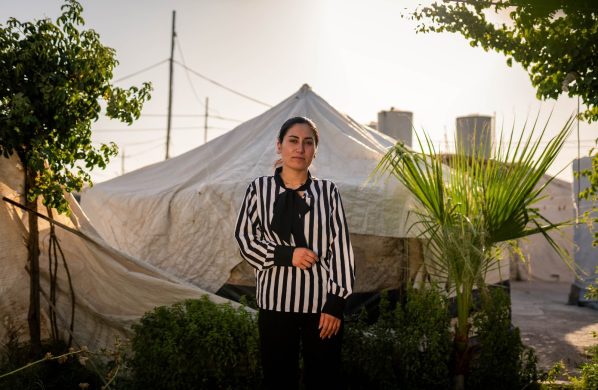Det libanesiske samfund er under pres fra 950.000 syriske flygtninge, der har søgt tilflugt i det lille land med under seks millioner indbyggere. De mange nye mennesker i landet har skabt boligmangel og øgede huslejepriser, mens lønninger styrtdykker, og gør det svært for libanesiske familier at få hverdagen til at hænge sammen.
BEIRUT, 18 March 2014 (UN News Centre): As the conflict in Syria enters its fourth year, there are nearly 2.5 million Syrians registered as refugees in Lebanon, Turkey, Jordan, Iraq and Egypt, according to the UN High Commissioner for Refugees.
The agency has registered over 950,000 Syrian refugees in Lebanon.
Also, the number of registered Syrian refugees does not include the hundreds of thousands of Syrians that are living in Lebanon without having asked for assistance, or the over 50,000 Palestinians who have fled to Lebanon since the start of the conflict, adding to the 270,000 that were already there.
Rising tensions
If the current influx of Syrian refugees into Lebanon – some 12,000 every week – continues, there could be over 1.6 million of them registered in the country by the end of this year. The presence of such a large number of refugees is exerting unprecedented pressure on public services and communities hosting the refugees.
It is also creating tension within the Lebanese population and could be a source of future friction, warned Mr. Mountain.
“Already we are seeing signs of tension, not surprisingly, between the Syrians that are arriving and the Lebanese host communities. But the fear that many of us have is that, that mixed with other factors could mean rising tension between communities within Lebanon.”
Syrian ghetto
He also noted that the bulk of the refugees are coming into parts of Lebanon where the poorest Lebanese live, in the Bekaa and Akkar regions. “There are 225 localities that contain 86 per cent of the refugees and 68 per cent of the poorest Lebanese. The problems that they have had before are of course exacerbated by this influx.”
Lebanon, he said, is now the largest per capita recipient of refugees anywhere in the world, and it is not in a position to support the Syrian refugees without substantial international help.
International support
Recognizing the multiple challenges facing Lebanon, including the massive influx of Syrian refugees, Secretary-General Ban Ki-moon last September established the International Support Group for Lebanon.
At its most recent meeting, held on 5 March in Paris, UN High Commissioner for Refugees António Guterres said that as a growing number of villages and towns now host more Syrians than Lebanese, the crisis is also putting unimaginable pressure on host communities. Water, sanitation and waste management systems are already weakened to the point that serious health consequences are emerging for refugees and locals alike.
Accommodation is in short supply, and rents have gone up nearly everywhere, stretching the resources of people in Lebanon’s poorest regions that host the largest refugee numbers, he continued. Wages are plummeting, and many Lebanese families are struggling to make ends meet as a result.
And yet, Lebanon is making an “unparalleled” contribution to the continued stability of the entire region, despite the enormous problems this is creating for its own society, Mr. Guterres told the meeting.
“Lebanon is a key pillar in the international framework for the protection of Syrian refugees, and without it, that entire system would collapse.”
Læs hele historien via kildelinket.














